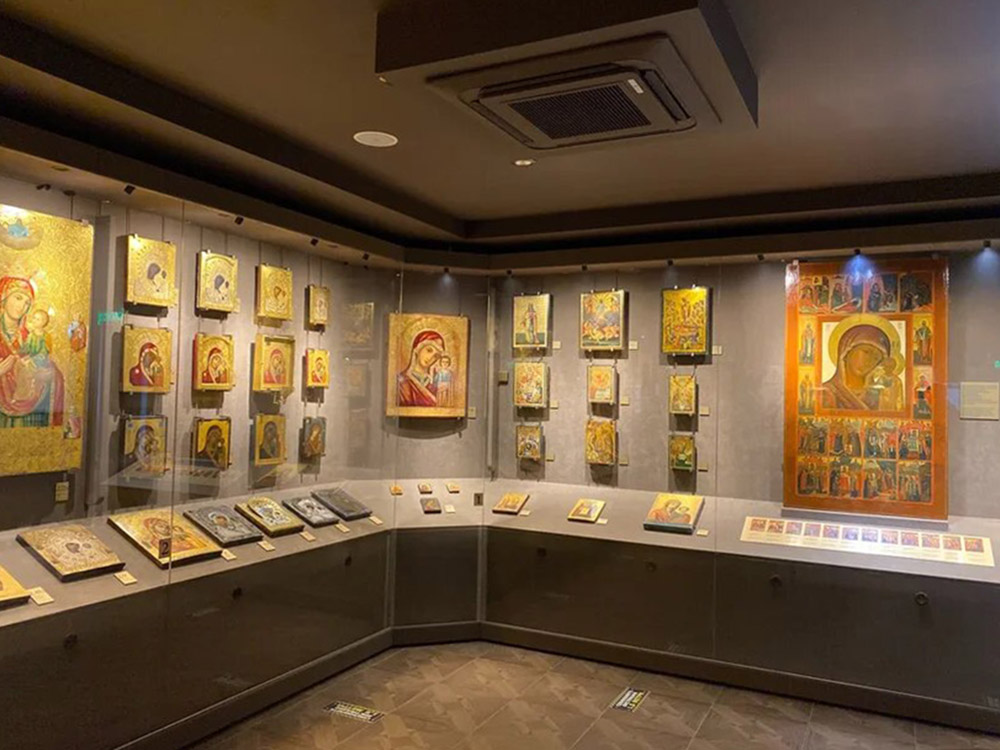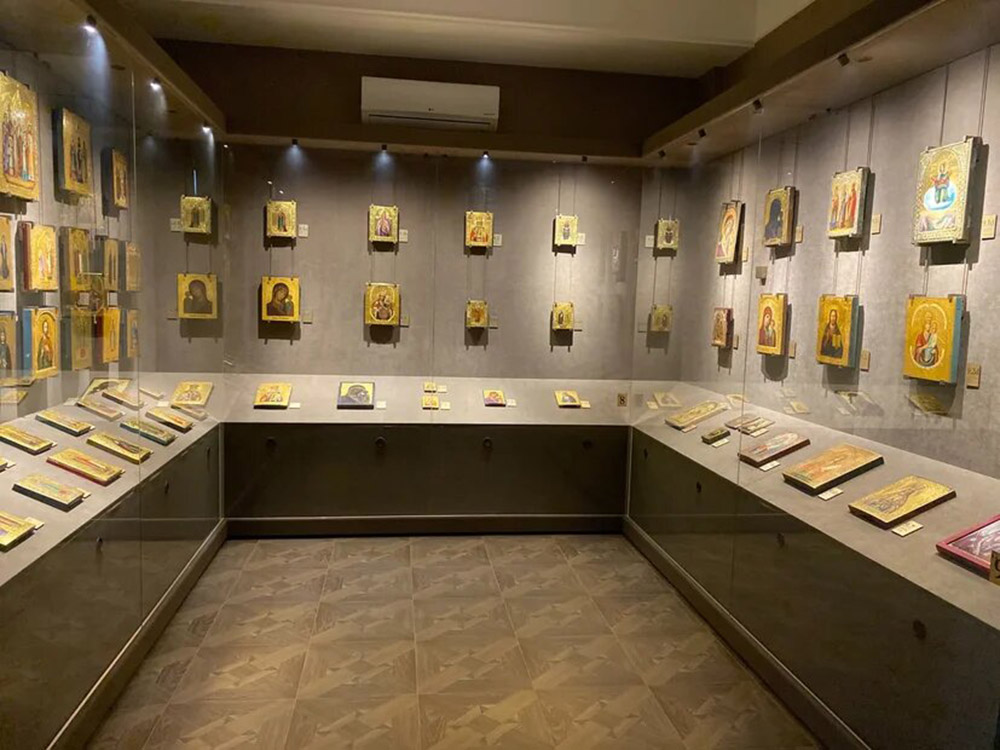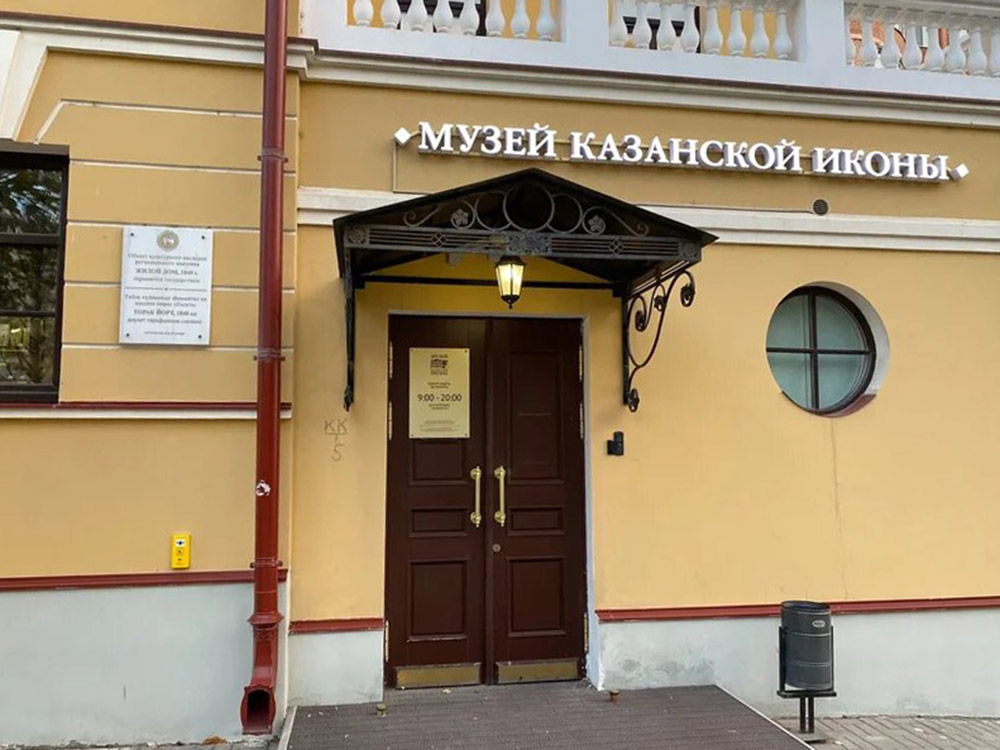
Collector and philanthropist Valery Sorokin has been studying local history for many years. He researches and promotes the Kazan region’s local history and writes books.
One of the objects of his research is icons. In 2019, Valery founded a private museum, where he gathered versions of the icons revered in the Kazan Eparchy — signed and dated icons, monuments of icon painting, painted on gold at different times by the nuns of the Kazan Bogoroditsky Monastery. In his opinion, all the exhibits, some of which are more than a hundred years old, are witnesses of the history of the Kazan region. The museum is located in a former merchant’s house near the Kazan Kremlin, not far from the Kazan Bogoroditsky Monastery. It is a historical place, it was here that the miraculous Kazan icon was revealed in 1579. The revealed icon became one of the most venerated in the Russian Orthodox Church, but in 1904, it was boldly stolen from the monastery, and it is still missing to this day. Valery Sorokin helped systematize the knowledge about the Kazan region, and the concept of “an icon by the Kazan Bogoroditsky Monastery workshop” was recognized in the scientific community.
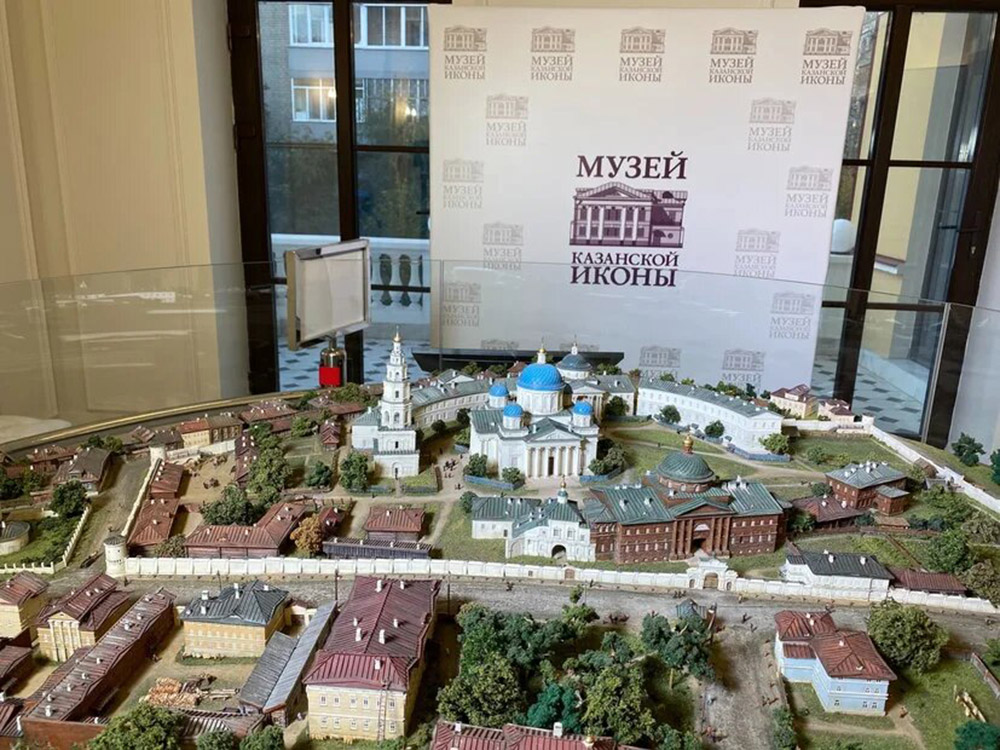
“When I was ten, my great aunt gave me a large 1804 copper nickel. Since my parents are Moscow University graduates, they saw the nickel and told me that 1804 was the year the University was founded. I was impressed by the fact that there was a great deal of history behind a small, useless in everyday life, piece of metal. And every time that you encounter some artifact and start to dig into its story, there is a discovery waiting for you. Over time this turned into something more serious: my interest in local history led me to specialize in icons,” says Valery Yuryevich.
Valery Sorokin wrote several books and compiled scientific collections on the topic of regional history, the history of the Kazan region. One of the books is Icons by the Kazan Bogoroditsky Monastery Workshop, Witnesses of the History of the Kazan Region, published last year in Kazan. A few copies of the book are available in the Russian State Library in Moscow.
“The books slowly led me to icons. In my understanding, this is the restoration of historical justice, it allowed me to fill a certain scientific niche, and now these icons are being recognized and talked about as Kazan icons. Before the publication of 2019, the Kazan icons were labeled as Volga icons, icons of central Russia, icons of the late 19th and early 20th century. Art historians had identified the area correctly, but no one was saying that this one was a Kazan icon, and this one was not,” the collector explained.
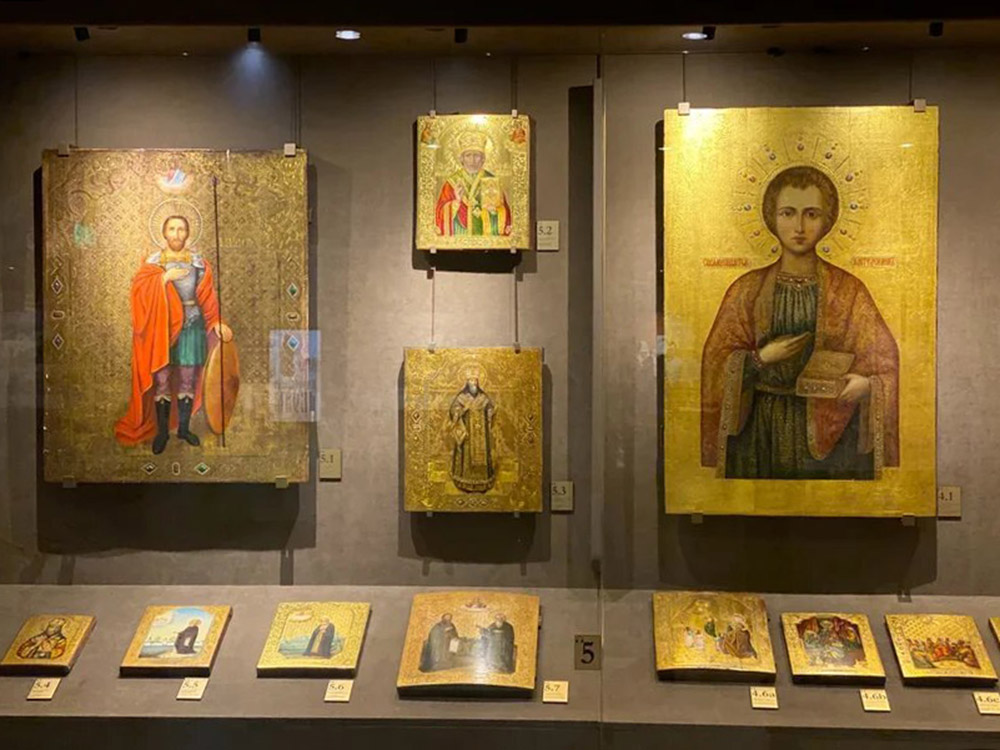
Valery Yuryevich inherited from his father many historical books, most of which are books about Kazan of the 18th and 19th centuries. There is a fine line between the topics of Kazan local history and Kazan icons, says Valery Yuryevich, because the Kazan church history and the Kazan Region history go hand in hand and are inextricably intertwined. “Take for example the right coast of the Volga river, all these lands are the fiefdoms of the Sviyazhsk Holy Trinity Monastery. The first monasteries of the Kazan region were what we now call the city-forming enterprises,” the founder of the Museum explained.
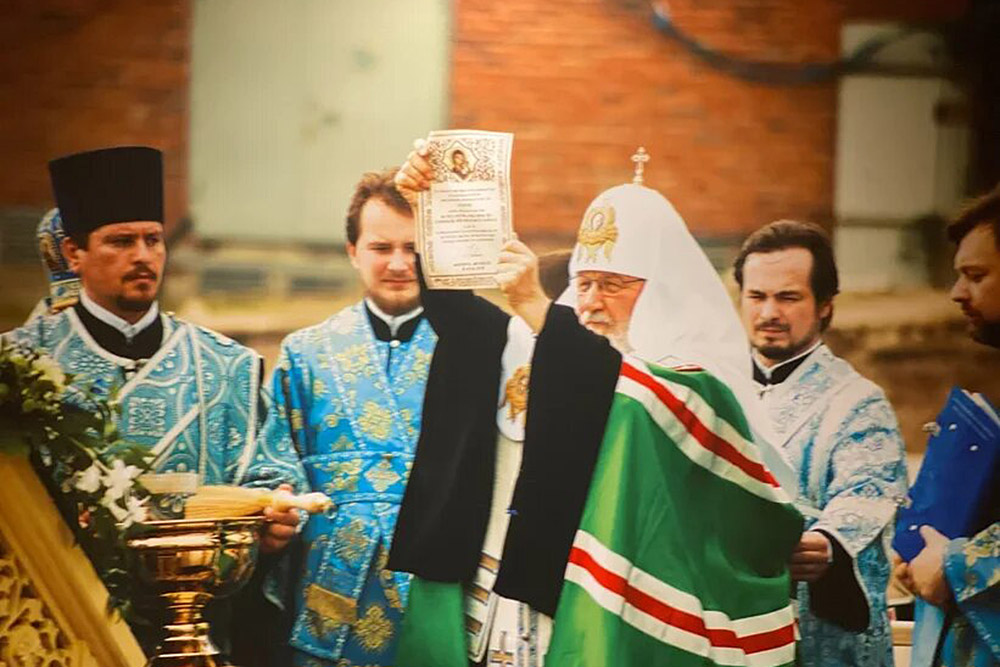
In 2019, at the opening ceremony of the Kazan Icon Museum, Metropolitan Feofan of Kazan and Tatarstan highly appreciated the idea of creating such a museum and stated that this event had become a common cause in preserving and reviving the moral image of Kazan. “It’s clear that behind this project there is a lot of hard work, deep knowledge, and love for the Kazan land, the Bogoroditsky Monastery, and the Our Lady of Kazan icon. I believe that the museum will become a landmark of the city and will be interesting for the guests of the city. Through the icon of Our Lady of Kazan, you can not only learn about Kazan but also get a blessing from the icon and from the place where the icon had first appeared. All this represents the cultural stance of Kazan, rooted in our spiritual values,” said the head of the archdiocese in Tatarstan.
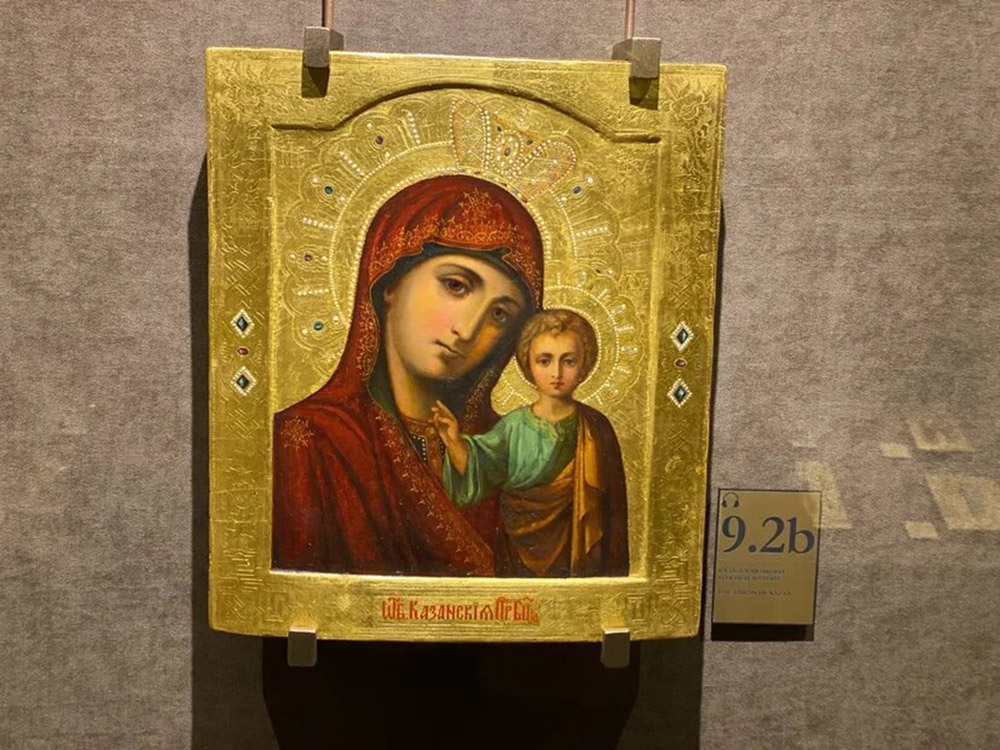
Speaking about the museum, Valery Sorokin clarified that it would be more correct from the methodical point of view to call the exhibition the Workshop Museum of the Kazan Bogoroditsky Monastery. The museum is dedicated to the history of the Kazan Region and the icon-painting workshop established in the late 1860s.
“Our museum tells the history of the monastery workshop, the city of Kazan, and the Kazan region. My personal interest in the collection is research. I love to dig deep, to seek out the truth. Icons, in this case, are material evidence related to historical events. Initially, I wanted to put Kazan on the map of Russian icon painting. After all, everyone knows Palekh, a folk craft in the Ivanovo region. Yaroslavl, Moscow, and St.Petersburg’s icons are also well-known, but Kazan icons seem to have never existed. As the first step in proving that Kazan had its own icon-painting manner, I was able to reliably prove that Kazan icons in the Kazan Bogoroditsky Monastery were painted according to a certain set of rules. The main type of icon painted in our monastery was, of course, Our Lady of Kazan, and our nuns synthesized many painting techniques and developed their own style, which could not be found anywhere else,” Valery Sorokin explained.
As we learned from Valery’s story, the past years were spent not on collecting icons per se, but mostly on understanding them. Now the concept of the Kazan icon painted in the monastery is known in the scientific community. “Kazan icon, not the icon of Our Lady of Kazan, but the school of icon painting is terra incognita (something unknown – ed. note) in the field of icon studies. In the 19th century, when researchers in Russia first set out to study the history of Russian icon painting, they mostly looked at ancient icons. Kazan icons at the time were considered household items, not historical artifacts. Later, after 1917, icon history was not the most relevant topic of research for obvious reasons, but even in Soviet times, the committed professionals carried on the research. In modern Russia, scientists and collectors joined the studies”, says Valery Sorokin.
In addition to the main icon type, Our Lady of Kazan, copies of other icons, venerated in the Kazan Eparchy, are also on display in the museum. For example, the miraculous Sedmiezer Icon of the Mother of God that has saved Kazan from the plague in the middle of the 17th century. The icon of the Nine Martyrs of Cyzicus, in whose honor the Cyzicus male Orthodox monastery in Kazan was founded. “Every icon from this display is linked to the history of the Kazan region. These icons are witnesses of history. Behind each of them is a story of some event that our ancestors considered miraculous and connected to the circumstances that had somehow helped them in their lives,” said Valery Sorokin.
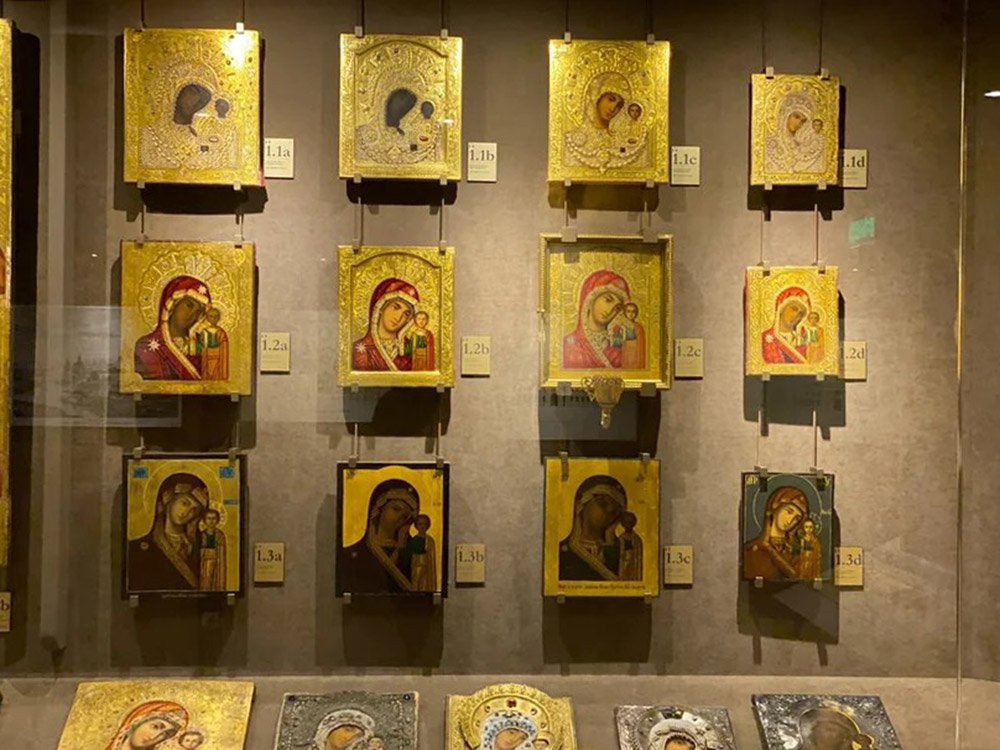
A separate exhibition hall is dedicated to the exhibits of special significance, the so-called signed and dated icons. They bear inscriptions by previous owners on the back: dates or other notes that tell us about the life of the icon. Only these records made it possible for Valery Sorokin to get an idea of the work in the icon-painting workshop and rescue Kazan icons from the oblivion of the past century.
On the first floor of the museum, a large screen plays a seven-minute video, briefly introducing the history of the Kazan Bogoroditsky Monastery and its icon painting workshop. The idea behind the video is to prepare visitors to watch the exhibition. So even before we enter the exhibition hall, we learn that the Kazan Monastery was founded in 1579 by Ivan the Terrible to commemorate the appearance of the Our Lady of Kazan icon on July 8, 1579. The first buildings in the monastery were made of wood, and only during the reign of Feodor Ivanovich, son of Ivan the Terrible, the first stone church was built. The monastery survived numerous fires, the most serious danger for any wooden city. Matrona Onuchina, daughter of a Kazan archer, found the icon of Our Lady of Kazan in the ashes. At the time, in the late 16th century, this was a place of archer settlements. By the end of the 16th century, the dilapidated main cathedral of the monastery was dismantled. The project of the new church was approved by Empress Catherine II herself. But it was her son, Emperor Paul I, who laid the foundation stone on May 30, 1798. In the 19th century, an icon painting workshop was founded in the monastery. The icons painted in the monastery have quickly developed a unique style and became widely recognizable. They had a great influence on the icon painting traditions in the Kazan region.
“The special effect that Kazan icons have on the worshipper is achieved by the use of transparent varnishes: the light from the lamp in front of such icon passed through the coats of varnishes, was reflected from the gold leaf, and created the effect of internal glow. This is just one of the many features of Kazan icons,” explained Valery Sorokin.
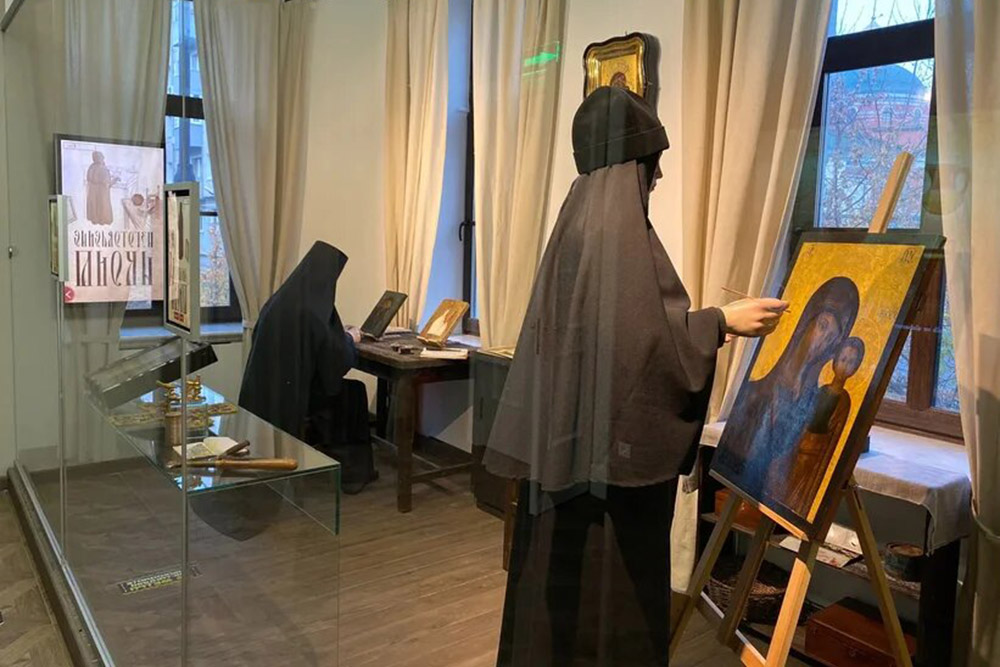
In the museum hall on the second floor, you can learn all the details and stages of making icons in the monastery workshop.
In the early 1920s, the Kazan Monastery was closed, and the buildings were repurposed for new uses. The main cathedral was destroyed altogether. But on November 4, 2015, the day of the autumn celebration of the Our Lady of Kazan icon, Rustam Minnikhanov, the President of the Republic of Tatarstan, issued a decree to rebuild the Kazan Cathedral. On the summer feast day of July 21, 2016, His Holiness Patriarch Kirill of Moscow and All Russia laid a commemoration capsule in the foundation of the church. The rebuilding of the Cathedral was made possible with the support of the Republican Fund for the revival of historical and cultural monuments of the Republic of Tatarstan, headed by the first President of Tatarstan Mintimer Shaymiyev.
At the opening ceremony of the Museum, Metropolitan Feofan of Kazan and Tatarstan noted that the reconstruction of the magnificent Kazan Cathedral in all its beauty showed that Our Lady of Kazan had once again shone over the city of Kazan and all Russia. These words restate the high significance of the Kazan Cathedral in Kazan for Russia.
Some of the icons in the museum have a common purpose, they were intended for home and family use. They were called house icons and made for private commissioners depicting the saints important to the commissioner.
For more than a hundred years, people argue about the theft of the miraculous Our Lady of Kazan icon from the Bogoroditsky monastery and its further fate. The icon was stolen from the main cathedral of the Kazan Bogoroditsky Monastery on the night of June 29, 1904. There are many legends and studies on the subject. Many religious people still hope to see it one day.
“Some time ago, I helped to republish the verbatim record of the icon theft case, a collection of articles, fictional and historical, about the case of the theft of the miraculous icon of Our Lady of Kazan. It’s as thrilling as a detective story. Anyone who reads the book can make up their own opinion on who is responsible for the loss,” Valery explained.
The Kazan Mother of God was the main subject painted in the monastery workshop. These icons had a common feature exclusive to Kazan icons: they all had the inscription reading “imagery and measurements taken from the revealed icon of Our Lady of Kazan”. But these icons had another unique feature.
“All the writers describe the Kazan icon as ‘an icon of Greek style and of dark color’. We see icons made with cold enamels, nuns used paint to imitate the pearl decoration on the icon, and we see an icon with a light face and with a dark face, this one is closer to what the nuns saw, the stolen icon looked something like that,” explains Valery Sorokin.
The Kazan icon was always displayed covered by an everyday icon riza, except for four feast days a year. But the decoration was still considered rich because the riza was set with more than a thousand large and small pearls and about five hundred diamonds. The police have recorded testimony by a nun, who opened the icon shortly before the theft to repair the riza. She named several identifying features of the stolen icon.
“Anyone who is somehow connected with the Kazan icon, of course, comfort themselves with the thought that sooner or later the icon will be found. But some scientific works are arguing that even if we find it now, we will not recognize it. No one has seen the icon without the cover, and the cover is the reason it was stolen. We know the shops that sold the stolen jewels, one of them was located near the Kazan hotel, it was a jewelry shop, some of the stolen pearls were on sale there,” confirmed Valery Yuryevich.
It is believed that the thief Bartholomew Stoyan, who lived in Kazan by the name of Fyodor Chaikin, was involved in the theft of the icon. The thief had several passports.
“I thought it was funny when I first read this case. Stoyan, who stole the icon, lived in Kazan with a fake name of Chaikin, but when they arrested him exiting the ship from Kazan to Nizhny Novgorod, he was going by the name Sorokin,” explained Valery Yurievich.
The Museum of the Kazan Icon is a unique place for tourists. You can choose a suitable way to visit the museum — spend some time alone with the icons or buy an audio guide. The audio guide is available in English as well. The full audio guide is about 90 minutes long, but you can choose a short version that is about 30 minutes long. You can take photos, but no flashlight is allowed. In the warmer months, you can go to the second-floor balcony offering the best panoramic views for photoshoots.
If you wish to learn more about the monastery or the icon workshop or buy a souvenir, you can visit the gift shop and choose from a variety of books on the subject, including books by Valery Yuryevich Sorokin.
